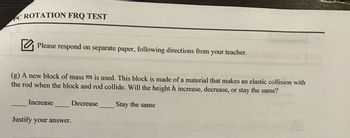A block of mass m is moving with speed v along a horizontal surface when it collides with a uniform rod of mass 2m and length L attached at one end to a pivot. The surface and pivot have negligible friction. The rod is vertical when the block collides with the end of the rod. The block sticks to the rod, and the block-rod system rotates so that the end of the rod reaches a height h, as shown above. The total rotational inertia of the rod about the pivot is 2m(L^2)/3. Express answers in parts (a), (b), and (c) in terms of m, L, v, and physical constants as appropriate. (a) Derive an expression for the angular speed ω of the block-rod system immediately after the collision. (b) Show that the change in height h of the bottom of the rod can be given by the equation h=3(v^2)/20g. (c) Derive an expression for the mechanical energy dissipated during the collision.
A block of mass m is moving with speed v along a horizontal surface when it collides with a uniform rod of mass 2m and length L attached at one end to a pivot. The surface and pivot have negligible friction. The rod is vertical when the block collides with the end of the rod. The block sticks to the rod, and the block-rod system rotates so that the end of the rod reaches a height h, as shown above. The total rotational inertia of the rod about the pivot is 2m(L^2)/3. Express answers in parts (a), (b), and (c) in terms of m, L, v, and physical constants as appropriate.
(a) Derive an expression for the angular speed ω of the block-rod system immediately after the collision.
(b) Show that the change in height h of the bottom of the rod can be given by the equation h=3(v^2)/20g.
(c) Derive an expression for the mechanical energy dissipated during the collision.
Student use the setup to determine an experimental value for the acceleration due to gravity g. The students use a block of mass 500g and a rod of mass 1.0kg and length 1.0m. For each trial, the rod is set in its vertical position, and the block is launched toward it. The speed of the block is varied for each trial, and the height h is measured. The data are shown in the chart below.
(d) Which quantities should be graphed on the vertical and horizontal axes to yield a straight line whose slope could be used to calculate a numerical value for the acceleration due to gravity g ? Use the remaining rows in the table above, as needed, to record any quantities that you indicated that are not given.
(e) Plot the experimental data for the quantities indicated in part (d) on the graph below. Clearly scale and label all axes including units, if appropriate. Draw a straight line that best represents the data.
(f) Using your straight line, determine an experimental value for g.
(g) A new block of mass is used. This block is made of a material that makes an elastic collision with the rod when the block and rod collide. Will the height increase, decrease, or stay the same?
____ Increase ____ Decrease ____ Stay the same
Trending now
This is a popular solution!
Step by step
Solved in 5 steps with 1 images

